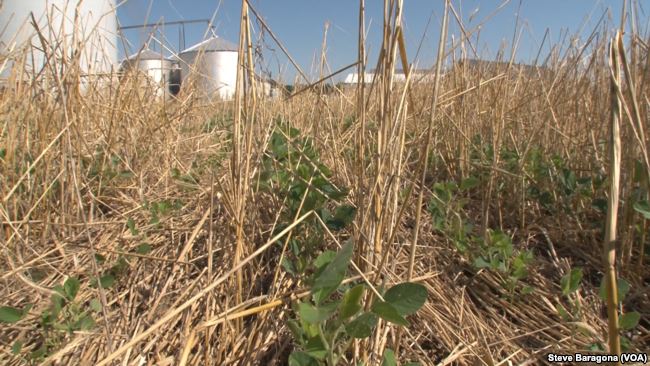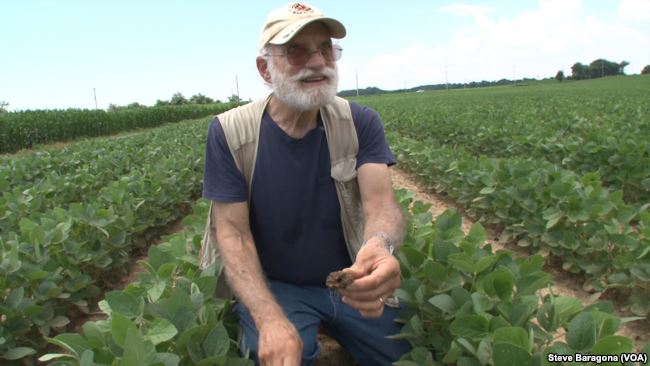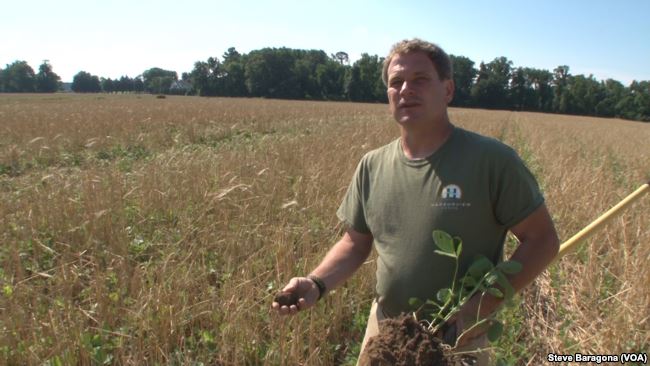VOAnews: Farmers Find Healthy Soils Yield Healthy Profits
July 20, 2017 4:45 PM | Steve Baragona
Ancient civilizations plowed themselves into oblivion, and modern agriculture risks doing it again, geologist David Montgomery says.
In his new book, Montgomery says a growing number of farmers are using techniques that can save their farms from slow death by erosion.
In Growing a Revolution: Bringing Our Soil Back to Life, Montgomery meets farmers who are building healthy soil and buffering themselves against climate change — and saving money while doing it — by practicing what is called conservation agriculture.
Experts worldwide are working to persuade farmers to reject thousands of years of agricultural tradition in order to save their soil.
Erosion of civilizations
Montgomery told VOA, while finishing his previous book, Dirt: The Erosion of Civilizations, “It was very difficult to write the final chapter and not have it sound really depressing.”
Dirt describes how tillage, one of the oldest practices in agriculture, degraded farms and civilizations from Mesopotamia to 1930’s Dust Bowl America.
Farmers till the soil to control weeds and make planting easier, but exposed soil washes away in the rain and blows away in the wind, carrying with it the nutrients plants need to thrive.
And yet, most farmers worldwide still plow their soil and leave it bare in the off-season. Many plant the same crops over and over again. All three practices wear out the soil.
Growing a Revolution picks up where Dirt ends, with the promise of a relatively new kind of farming.
“Conservation agriculture flip[s] all three of those ideas on their head,” he said. “It’s a completely different philosophy to not till, to always have the ground covered with either a commercial crop or a cover crop, and to grow a much more diverse rotation.”

Trey Hill’s no-till soybeans grow through the remnants of the previous season’s cover crop in Maryland.
Trouble in tidy fields
Trey Hill of Maryland has not tilled his soybean field in years. The young crop peeks out from below waist-high brown stalks of what remains of last year’s cover crop, a mix of grains, legumes, radishes and more.
“If you don’t like your fields to look like a mess,” Hill said with a laugh, “it has to kind of grow on you. Yet, I have a lot of other owners and peers that are, like, ‘Wow, what you’re doing is really exciting.'”
A short drive away, in a neighbor’s conventionally tilled field, soybeans grow in neat and tidy lines on a clean slate of bare earth.
University of Maryland soil scientist Ray Weil sees signs of trouble. The lower leaves of the soybean plants are splashed with mud from a rainstorm two nights earlier.
“When it rained, that soil went flying,” Weil said. “When the soil goes flying, it goes running down the slope. That’s the first step in soil erosion.”
Just a few millimeters below the surface, he finds soybean roots growing sideways, unable to penetrate a layer of hard earth packed down by the effects of tillage. If it turns dry later in the summer, he said, “they’re going to be crying uncle for water.”

University of Maryland soil scientist Ray Weil says tilled soil erodes more easily and holds less water.
‘Farming ugly’
“When no-till started, they called it ‘farming ugly,'” Weil said.
Hill’s “ugly” field is pretty on the inside. The roots of the cover crop he planted last year held onto the soil and its precious nutrients through the winter. Legumes added nitrogen, a key fertilizer. Earthworms feasting on the decomposing plants dig tunnels in the earth. Those pores soak up rainfall like a sponge, and they provide paths for the roots of Hill’s soybeans to grow through.
Cushioning against droughts and downpours, these soils help Hill through the weather extremes that are becoming more frequent with climate change.
And Hill is saving money. Less tilling means paying for less tractor fuel. He buys less fertilizer because his cover crops feed the soil.
“It all means more income to the farmer,” Hill said.
Profits for big and small farms
Conservation agriculture is also working on small farms in the developing world.
“What surprised me was how profitable these techniques can be in both settings,” Montgomery said.
Montgomery visited Ghana, where traditional slash-and-burn farming is degrading the soil, but conservation agriculture is turning fields into food forests. Farmers raised multiple crops on the same field, keeping the ground covered year ’round.
“You would have, say, an overstory of plantains and an understory of peppers and cassava,” he said. “If I’d squinted and didn’t know better, I might have sworn I was in a jungle, but everything around me was food.”
The spread of conservation agriculture has been slow. The transition can take several years. Weeds can cut yields in that time. Equipment designed to work on bare earth may not operate on cover-cropped fields.
Developing world farmers, in particular, often remove the residues of one crop before planting the next, to feed livestock, thatch roofs, or use as cooking fuel.
“There’s lots of uses,” Weil said. “But the residues need to be left in the field, at least most of them, to feed the soil.”
“Lots of barriers to giving it a try,” he added. “But once you get going, it’s cheaper.”
Cheaper, soil-saving and climate-friendly, experts worldwide are helping farmers switch to conservation agriculture and consign the plow to the history books.
